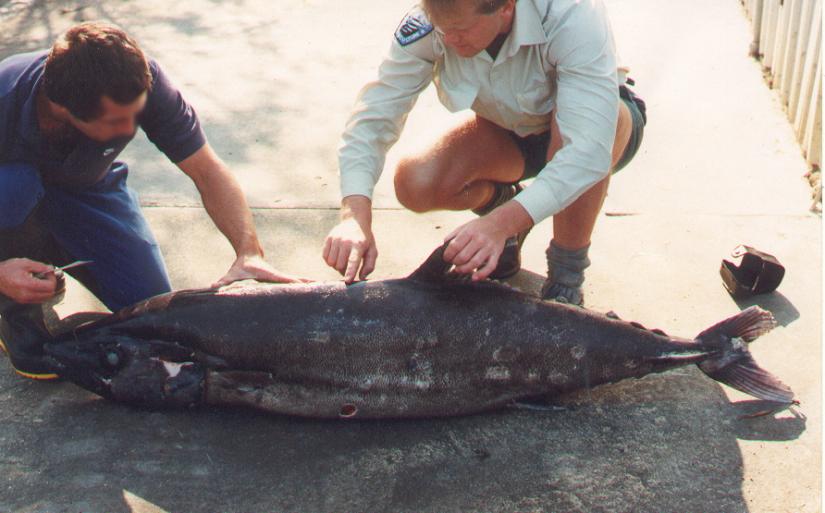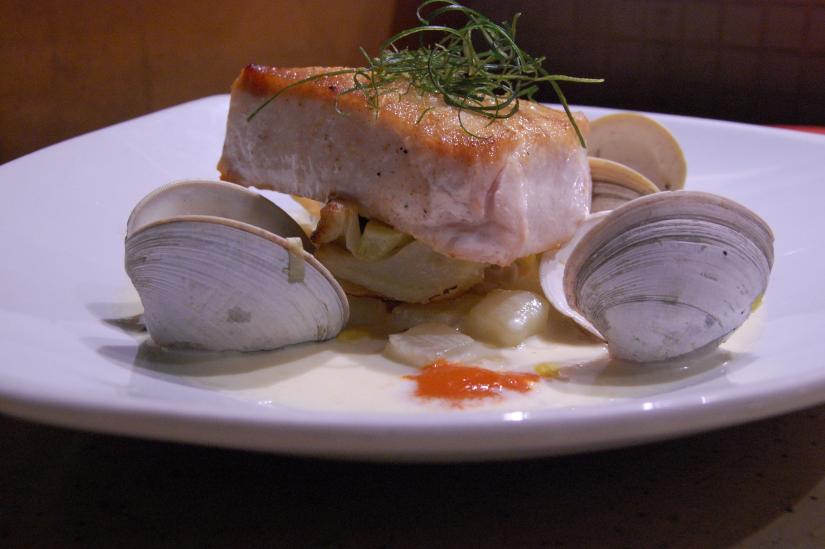Escolar
Lepidocybium flavobrunneum
The Science
THE SCIENCE
The escolar’s large eyes cause it to have extremely high optical sensitivity and thrive in deep dark waters.

Taxonomic description
- Reaches lengths of 2 meters (6 ft.) long [2], and can weigh up to 45 kg (99 lbs). [3]
- Has large eyes adapted to the dark, deep sea. [2]
- Has dark brown, grey, and black body color helps it to stay camouflaged in the mesopelgic light. [2]
- Its lower jaw slightly projects beyond the upper – 2 pairs of fang-like teeth in the upper jaw. [12]
Distribution
-
Found worldwide in tropical and subtropical seas. [1,3]
Life history
- Reaches sexual maturity at 30-35 cm (11-14). [5]
- Peak catches in May and November indicate possible birth and feeding times. [9]
- May endure long migrations to feeding/reproductive areas but these activities are poorly understood. [14]
- Lifespan likely extends beyond 11 years. [14]
Habitat
- Lives in cold depths over 200 meters (656 ft.) during the day and migrates to the surface in tropical warm waters during the night. [2]
- Mainly caught in nearshore waters that have bottom ridges, steep drop-offs, or ledge features. [1,14]
- Likely is a slow moving, sit-and-wait predator that eats squid, crustaceans, and fishes (bramids, coryphaenids, scombrids, and trachipterids). [2,3,14]
The Fishery
THE FISHERY
Escolar is found in warm waters and is an incidental catch of the tuna fishing industry.

Seasonal availability
- Available year round. [7]
Regulatory and managing authority
- Although there is no directed fishery for this species, escolar is caught as bycatch and is overseen by NOAA fisheries and, as established by the Magnuson-Stevens Act, the Pacific Fishery Management Council through the West Coast Highly Migratory Species Fisheries Management Plan. It is managed as an Ecosystem Component Species. [13]
- As established by the Marine Life Management Act, the California Department of Fish and Wildlife (CDFW) collects data on this fishery. [16]
Gear type
- There is a Pelagic longline fishery used in tropical oceans and the Pacific ocean, but is prohibited within 200 miles of the U.S coast. [5]
- Circle hooks [3], purse seine and observers are often used. [15]
Status of the fishery
- There is no specific fishery at the national or international level. [5]
- There is little information on the species and stocks [5,14], although populations are thought to fluctuate. [3]
- In the south Atlantic Ocean a decline in mean average weight suggests commercial fishing may be decreasing population [9] but the status of escolar appear to be stable elsewhere, suggesting no overfishing or other major threats. [1,3]
Potential ecosystem impacts
- Longline fishing often has issues with bycatch. [9,14]
The Seafood
THE SEAFOOD
Approximately 20% of an escolar’s body weight is made up of indigestible waxy esters, which can have a laxative and purgative effect on those that eat large quantities of this fish.


Edible portions
- Dorsal loin muscle. [10]
Description of meat
- Has silky, soft white meat that is rich in flavor and fiber; approximately 66% moisture content. [8,11]
Culinary uses
- It is obtained fresh with skin off or on, whole or fillets, and should be eaten fresh within 2 days. If frozen it should be eaten on the day it is thawed. [11]
- Cooking methods: bake, broil, grill, poach, sauté, steam, and raw. [11]
- It is commonly used at sushi restaurants as sashimi or in rolls; can also be eaten as a fillet but not usually prepared in rich creams because of its high fat content. [11]
- For a sushi roll recipe using escolar, visit Secrets of Sushi. [17]
- For a recipe for grilled escolar, visit Emeril Lagasse. [18]
Nutritional information
- Approximately 20% of the escolar’s body weight contains indigestible wax esters which cause laxative/purgative qualities. [1,10]
- It is high in energy due to the high fat content in muscles, and is a good source of protein. [10]
Toxicity report
- There are low levels of histamine in escolar, so the US FDA co-manages the associated health risks by checking the market for histamine levels. [1]
- Because eating too much of escolar can have laxative effects, and because it has sometimes been mislabelled in some markets and restaurants by other fish names like tuna, sea bass, oilfish, and cod, escolar is banned in Italy and Japan. [3,11]
- To enjoy this fish without the laxative effects, eat no more than six ounces at a time. [3]
Seasonal availability
- Year round. [7]
References
[1] Hwang, C-C. L. Chia-Min, Lin., H. Chun-Yung,,H. Ya-Ling, K. Fang-Chin, H. Deng-Fwu., and T. Yung-Hsian., 2012. Chemical characterization, biogenic amines contents, and identification of fish species in cod and escolar steaks, and salted escolar roe products. Food Control. Volume 1. 415-420. https://doi.org/10.1016/j.foodcont.2011.11.008
[2] Landgren, E., K. Fritsches., R. Brill, E. Warrant. 2014. The visual ecology of a deep-sea fish, the escolar Lepidocybium flavobrunneum. Philosophical Transactions of the Royal Society B: Biological Sciences. Volume 369. 1-12. https://doi.org/10.1098/rstb.2013.0039
[3] Smith-Vaniz, W.F., J. Williams, F. Pina Amargos, F., M. Curtis & L. Grijalba Bendeck, L. 2015. Lepidocybium flavobrunneum. The IUCN Red List of Threatened Species 2015. Web. https://www.iucnredlist.org/species/190287/16510672. Accessed 28 August 2020.
[4] Cook, C. 2015. Tuna Troubles. Web. https://danasartandscienceblog.files.wordpress.com/2015/03/drifting_long_line.gif. Accessed 29 May, 2017.
[5] Keller, H. R. D.W. Kerstetter,. 2014. Length–length and length–weight relationships of oilfish (Ruvettus pretiosus), escolar (Lepidocybium flavobrunneum), snake mackerel (Gempylus serpens), and longnose lancetfish (Alepisaurus ferox) from the Gulf of Mexico and the western North Atlantic Ocean. Journal of Applied Ichthyology. Volume 30. 241–243. https://doi.org/10.1111/jai.12229
[6] Raisfeld, Robin and Patronite, Rob, The “It” Fish. Web. http://nymag.com/restaurants/features/16899/ Web. 17 Apr. 2017.
[7] Dr. Theresa Sinicrope Talley. 2014. Seafood Profiles: Commercial species of San Diego.
[8] Suptijah, P., Suseno, S., Hayati, S. , Faradila, R., Nurjanah, Nugraha, R., and Saraswati. 2014. Inventory and Extraction of Taurine from Deep Sea Fishes: Escolar (Lepidocybium flavobrunneum) and Lobster. Czech Journal of Food Sciences. Volume 2. 241-247. http://dx.doi.org/10.19026/ajfst.6.18
[9] Levesque, Juan Carlos. 2010. Evolving Fisheries: Today’s Bycatch is Tomorrow’s Target Catch-Escolar (Lepidocybium flavobrunneum) Catch in the U.S. Pelagic Longline Fishery.The Open Fish Science Journal 3. 30-41. http://dx.doi.org/10.2174/1874401X01003010030
[10] Buchtova, H., Dordevic, D., Kocarek, S., and Chomat, P. 2015. Analysis of Chemical and Sensory Parameters in different kinds of escolar (Lepidocybium flavobrunneum) products. Czech Journal of Food Sciences. Volume 4. 346-353. https://doi.org/10.17221/435/2014-CJFS
[11] Professional culinary, Chefs Resources. Escolar Fish Culinary Profile. Web. http://www.chefs-resources.com/seafood/finfish/escolar/. Accessed 17 Apr. 2017.
[12] Smith, A. Escolar. Marine Species Identification Portal: Escolar - Lepidocybium flavobrunneum. Web. http://species-identification.org/species.php?species_group=fnam&id=1954. 17 Apr. 2017.
[13] Fishery Management Plan for U.S. West Coast Fisheries for Highly Migratory Species. 2018. Pacific Fishery Management Council. Web. https://www.pcouncil.org/documents/2018/04/fishery-management-plan-for-…. Accessed 24 August 2020.
[14] Smith-Vaniz, W.F., Williams, J., Pina Amargos, F., Curtis, M. & Grijalba Bendeck, L. 2015. Lepidocybium flavobrunneum. The IUCN Red List of Threatened Species 2015: e.T190287A16510672. http://dx.doi.org/10.2305/IUCN.UK.2015-4.RLTS.T190287A16510672.en. 28 May 2017.
[15] Escolar. n.d. Myfitnesspal.com. Web. https://www.myfitnesspal.com/food/calories/escolar-raw-199163532. Accessed 21 September 2017.
[16] Marine Life Management Act. n.d. California Department of Fish and Wildlife. Web. https://wildlife.ca.gov/Conservation/Marine/MLMA. Accessed 24 August 2020.
[17] Sekine, B. Secrets of Sushi. 2014. Great White Roll. Web. https://secretsofsushi.com/great-white-roll.html. Accessed 13 January 2021.
[18] Lagasse, E. n.d. Grilled Escolar with a saute of fresh asparagus, baby morels, and currant tomatoes. Web. https://www.emerils.com/124324/grilled-escolar-saute-fresh-asparagus-ba…. Accessed 13 January 2021.
[19] Sandoval, G. M. iNaturalist. 2011. Digital image. Web. https://www.inaturalist.org/photos/29082750. Accessed 16 February 2021.
[20] ian_merrington. iNaturalist. 2010. Digital image. Web. https://www.inaturalist.org/photos/38118117. Accessed 16 February 2021.
[21] Anderson, J.D. iNaturalist. 2018. IMG_6279 FV Maverick. Digital image. Web. https://flickr.com/photos/jon_d_anderson/28305136619. Accessed 16 February 2021.
[22] stu_spivack. flickr. 2008. escolar. Digital image. Web. https://flickr.com/photos/stuart_spivack/3094983708. Accessed 16 February 2021.



